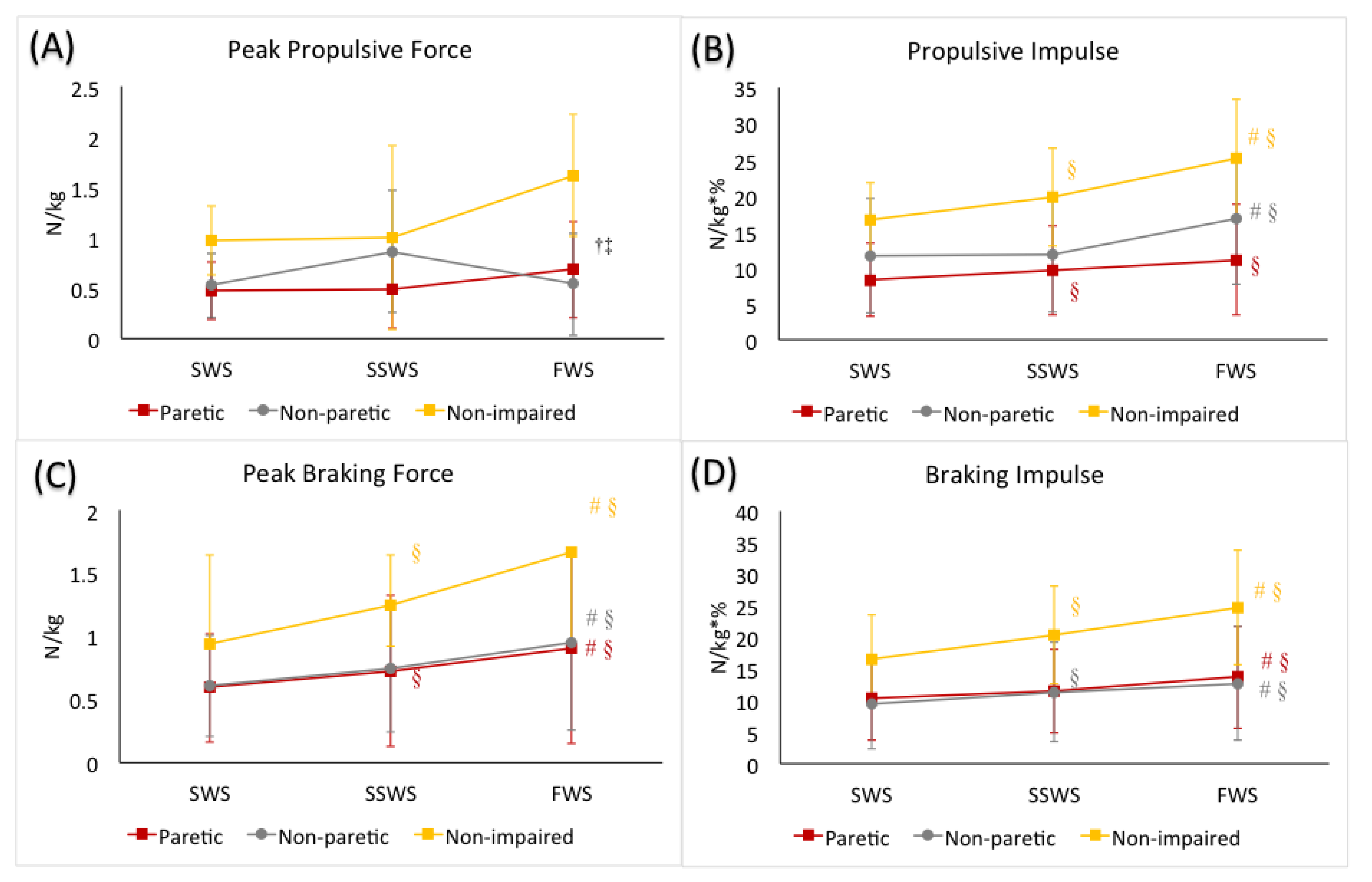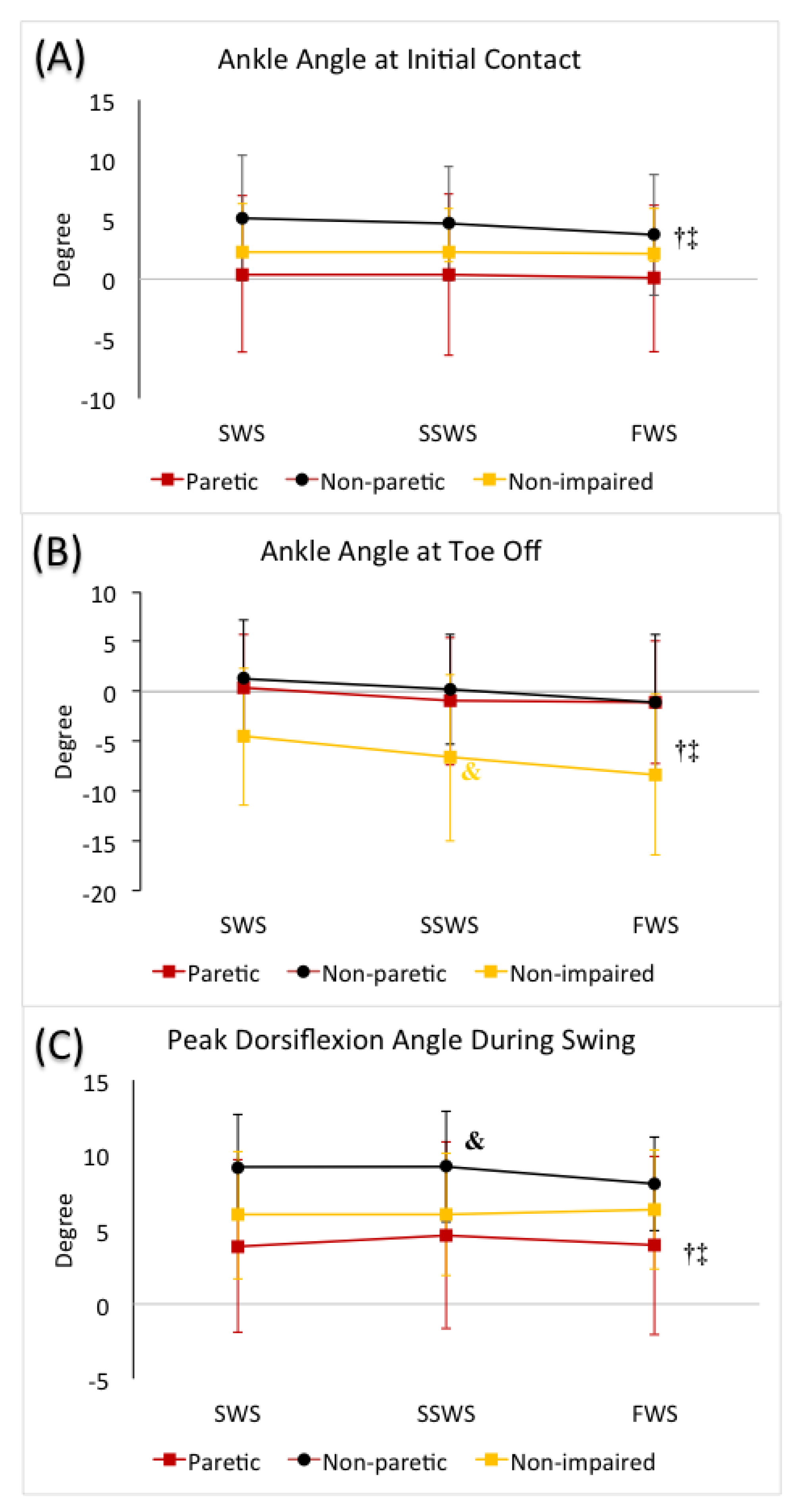Slow Walking in Individuals with Chronic Post-Stroke Hemiparesis: Speed Mediated Effects of Gait Kinetics and Ankle Kinematics
Abstract
1. Introduction
2. Materials and Methods
2.1. Participants
2.2. Procedures
2.3. Data Analysis
2.4. Statistical Analysis
3. Results
3.1. Walking Speeds
3.2. Kinetics
3.2.1. Peak Propulsive Force during Stance
3.2.2. Propulsive Impulse during Stance
3.2.3. Peak Braking Force during Stance
3.2.4. Braking Impulse during Stance
3.3. Kinematics
3.3.1. Ankle Angle at Initial Contact
3.3.2. Ankle Angle at Toe off
3.3.3. Peak Dorsiflexion during Swing
4. Discussion
5. Conclusions
Author Contributions
Funding
Institutional Review Board Statement
Informed Consent Statement
Acknowledgments
Conflicts of Interest
References
- Benjamin, E.J.; Virani, S.S.; Callaway, C.W.; Chamberlain, A.M.; Chang, A.R.; Cheng, S.; Chiuve, S.E.; Cushman, M.; Delling, F.N.; Deo, R.; et al. Heart Disease and Stroke Statistics-2018 Update: A Report From the American Heart Association. Circulation 2018, 137, e67–e492. [Google Scholar] [CrossRef]
- Olney, S.J.; Richards, C. Hemiparetic gait following stroke. Part I: Characteristics. Gait Posture 1996, 4, 136–148. [Google Scholar] [CrossRef]
- Perry, J.; Garrett, M.; Gronley, J.K.; Mulroy, S.J. Classification of walking handicap in the stroke population. Stroke 1995, 26, 982–989. [Google Scholar] [CrossRef] [PubMed]
- von Schroeder, H.P.; Coutts, R.D.; Lyden, P.D.; Billings, E., Jr.; Nickel, V.L. Gait parameters following stroke: A practical assessment. J. Rehabil. Res. Dev. 1995, 32, 25–31. [Google Scholar] [PubMed]
- Grau-Pellicer, M.; Chamarro-Lusar, A.; Medina-Casanovas, J.; Serdà Ferrer, B.C. Walking speed as a predictor of community mobility and quality of life after stroke. Top. Stroke Rehabil. 2019, 26, 349–358. [Google Scholar] [CrossRef]
- Orendurff, M.S.; Schoen, J.A.; Bernatz, G.C.; Segal, A.D.; Klute, G.K. How humans walk: Bout duration, steps per bout, and rest duration. J. Rehabil. Res. Dev. 2008, 45, 1077–1089. [Google Scholar] [CrossRef] [PubMed]
- Al-Yahya, E.; Dawes, H.; Smith, L.; Dennis, A.; Howells, K.; Cockburn, J. Cognitive motor interference while walking: A systematic review and meta-analysis. Neurosci. Biobehav. Rev. 2011, 35, 715–728. [Google Scholar] [CrossRef]
- Orendurff, M.S.; Segal, A.D.; Berge, J.S.; Flick, K.C.; Spanier, D.; Klute, G.K. The kinematics and kinetics of turning: Limb asymmetries associated with walking a circular path. Gait Posture 2006, 23, 106–111. [Google Scholar] [CrossRef]
- Gérin-Lajoie, M.; Richards, C.L.; McFadyen, B.J. The negotiation of stationary and moving obstructions during walking: Anticipatory locomotor adaptations and preservation of personal space. Motor Control 2005, 9, 242–269. [Google Scholar] [CrossRef]
- Nilsson, J.; Thorstensson, A. Ground reaction forces at different speeds of human walking and running. Acta Physiol. Scand. 1989, 136, 217–227. [Google Scholar] [CrossRef]
- Wu, A.R.; Simpson, C.S.; van Asseldonk, E.H.F.; van der Kooij, H.; Ijspeert, A.J. Mechanics of very slow human walking. Sci. Rep. 2019, 9, 18079. [Google Scholar] [CrossRef]
- Bowden, M.G.; Balasubramanian, C.K.; Neptune, R.R.; Kautz, S.A. Anterior-posterior ground reaction forces as a measure of paretic leg contribution in hemiparetic walking. Stroke 2006, 37, 872–876. [Google Scholar] [CrossRef]
- Liang, J.N.; Brown, D.A. Foot force direction control during a pedaling task in individuals post-stroke. J. Neuroeng. Rehabil. 2014, 11, 63. [Google Scholar] [CrossRef]
- Kesar, T.M.; Reisman, D.S.; Perumal, R.; Jancosko, A.M.; Higginson, J.S.; Rudolph, K.S.; Binder-Macleod, S.A. Combined effects of fast treadmill walking and functional electrical stimulation on post-stroke gait. Gait Posture 2011, 33, 309–313. [Google Scholar] [CrossRef]
- den Otter, A.R.; Geurts, A.C.; Mulder, T.; Duysens, J. Speed related changes in muscle activity from normal to very slow walking speeds. Gait Posture 2004, 19, 270–278. [Google Scholar] [CrossRef]
- Holden, J.P.; Chou, G.; Stanhope, S.J. Changes in knee joint function over a wide range of walking speeds. Clin. Biomech. 1997, 12, 375–382. [Google Scholar] [CrossRef]
- Nymark, J.R.; Balmer, S.J.; Melis, E.H.; Lemaire, E.D.; Millar, S. Electromyographic and kinematic nondisabled gait differences at extremely slow overground and treadmill walking speeds. J. Rehabil. Res. Dev. 2005, 42, 523–534. [Google Scholar] [CrossRef] [PubMed]
- Brandt, T.; Strupp, M.; Benson, J. You are better off running than walking with acute vestibulopathy. Lancet 1999, 354, 746. [Google Scholar] [CrossRef]
- Dietz, V.; Baaken, B.; Colombo, G. Proprioceptive input overrides vestibulo-spinal drive during human locomotion. Neuroreport 2001, 12, 2743–2746. [Google Scholar] [CrossRef]
- Horak, F.B.; Hlavacka, F. Somatosensory loss increases vestibulospinal sensitivity. J. Neurophysiol. 2001, 86, 575–585. [Google Scholar] [CrossRef]
- Liang, J.N.; Ho, K.-Y.; Hung, V.; Reilly, A.; Wood, R.; Yuskov, N.; Lee, Y.-J. Effects of augmented somatosensory input using vibratory insoles to improve walking in individuals with chronic post-stroke hemiparesis. Gait Posture 2021, 86, 77–82. [Google Scholar] [CrossRef]
- Liang, J.N.; Brown, D.A. Impaired foot-force direction regulation during postural loaded locomotion in individuals poststroke. J. Neurophysiol. 2013, 110, 378–386. [Google Scholar] [CrossRef] [PubMed]
- Liang, J.N.; Brown, D.A. Impaired H-Reflex Gain during Postural Loaded Locomotion in Individuals Post-Stroke. PLoS ONE 2015, 10, e0144007. [Google Scholar] [CrossRef]
- Redfern, M.S.; Cham, R.; Gielo-Perczak, K.; Grönqvist, R.; Hirvonen, M.; Lanshammar, H.; Marpet, M.; Pai, C.Y.; Powers, C. Biomechanics of slips. Ergonomics 2001, 44, 1138–1166. [Google Scholar] [CrossRef] [PubMed]
- Harris-Love, M.L.; Forrester, L.W.; Macko, R.F.; Silver, K.H.; Smith, G.V. Hemiparetic gait parameters in overground versus treadmill walking. Neurorehabil. Neural Repair 2001, 15, 105–112. [Google Scholar] [CrossRef] [PubMed]


| Stroke-Impaired (n = 15) | Non-Neurologically Impaired (n = 15) | |
|---|---|---|
| Age (mean ± SD, years) | 61.52 ± 8.78 | 59.32 ± 10.52 |
| Sex (number) | 8 F/7 M | 11 F/4 M |
| Slow walking speed (mean ± SD, m/s) | 0.37 ± 0.23 † | 0.65 ± 0.21 |
| Self-selected walking speed (mean ± SD, m/s) | 0.47 ± 0.28 † | 0.92 ± 0.19 |
| Fast walking speed (mean ± SD, m/s) | 0.57 ± 0.34 † | 1.03 ± 0.35 |
| Time post-stroke (mean ± SD, years) | 2.76 ± 1.76 | - |
| LE Fugl-Meyer score (/34) | 25.80 ± 3.72 | - |
| Paretic limb (number) | 7 Left/8 Right | - |
| Slow Walking Speed (SWS) | Self-Selected Walking Speed (SSWS) | Fast Walking Speed (FWS) | ||
|---|---|---|---|---|
| Peak Propulsive Force (n/Kg) | Paretic | 0.48 ± 0.29 | 0.61 ± 0.40 | 0.71 ± 0.49 |
| Non-paretic | 0.54 ± 0.32 | 0.68 ± 0.42 | 0.89 ± 0.50 | |
| Non-impaired | 0.97 ± 0.34 | 1.00 ± 0.91 | 1.61 ± 0.60 | |
| Averaged across 3 Limbs | 0.66 ± 0.32 | 0.77 ± 0.64 | 1.09 ± 0.66†,‡ | |
| Propulsive Impulse (n/Kg * %) | Paretic | 8.53 ± 5.20 | 9.85 ± 6.28 § | 11.55 ± 7.83 § |
| Non-paretic | 11.96 ± 7.69 | 12.34 ± 7.97 | 17.25 ± 8.90 #,§ | |
| Non-impaired | 16.64 ± 5.10 | 19.81 ± 6.84 § | 25.15 ± 8.09 #,§ | |
| Peak Braking Force (n/Kg) | Paretic | 0.59 ± 0.33 | 0.72 ± 0.40 § | 0.91 ± 0.55 #,§ |
| Non-paretic | 0.60 ± 0.38 | 0.75 ± 0.50 § | 0.96 ± 0.67 #,§ | |
| Non-impaired | 0.94 ± 0.43 | 1.25 ± 0.60 § | 1.66 ± 0.76 #,§ | |
| Braking Impulse (n/Kg * %) | Paretic | 10.37 ± 6.50 | 11.52 ± 6.68 | 13.83 ± 7.94 #,§ |
| Non-paretic | 9.53 ± 5.98 | 11.33 ± 7.30 § | 13.16 ± 8.46 #,§ | |
| Non-impaired | 16.53 ± 6.98 | 20.31 ± 7.82 § | 24.72 ± 9.06 #,§ |
| Slow Walking Speed (SWS) | Self-Selected Walking Speed (SSWS) | Fast Walking Speed (FWS) | Averaged across 3 Speeds | ||
|---|---|---|---|---|---|
| Ankle Angle at Initial Contact (°) | Paretic | 0.5 ± 5.8 | 0.4 ± 6.8 | 0.0 ± 5.4 | |
| Non-paretic | 5.0 ± 5.0 | 4.7 ± 4.8 | 3.6 ± 4.9 | ||
| Non-impaired | 2.3 ± 4.0 | 2.3 ± 3.6 | 2.1 ± 3.7 | ||
| Averaged across 3 Limbs | 2.6 ± 5.2 | 2.4 ± 5.1 | 1.9 ± 4.8†,‡ | ||
| Ankle Angle at Toe off (°) | Paretic | 0.6 ± 4.7 | −1.0 ± 5.9 | −1.7 ± 5.9 | −0.7 ± 6.0 |
| Non-paretic | 1.3 ± 5.7 | 0.2 ± 5.5 | −1.2 ± 6.5 | 0.1 ± 6.1 | |
| Non-impaired | −4.5 ± 6.9 | −6.7 ± 8.4 | −8.4 ± 8.0 | −6.5 ± 7.8 & | |
| Averaged across 3 Limbs | −0.9 ± 6.3 | −2.6 ± 7.3‡ | −3.9 ± 7.5†,‡ | ||
| Peak Dorsiflexion during Swing (°) | Paretic | 3.9 ± 4.7 | 4.6 ± 5.2 | 4.0 ± 5.0 | 4.1 ± 6.0 |
| Non-paretic | 9.4 ± 3.5 | 9.2 ± 3.7 | 8.4 ± 3.3 | 9.0 ± 3.5 & | |
| Non-impaired | 6.0 ± 4.3 | 6.0 ± 4.1 | 6.3 ± 4.0 | 6.1 ± 4.1 |
Publisher’s Note: MDPI stays neutral with regard to jurisdictional claims in published maps and institutional affiliations. |
© 2021 by the authors. Licensee MDPI, Basel, Switzerland. This article is an open access article distributed under the terms and conditions of the Creative Commons Attribution (CC BY) license (http://creativecommons.org/licenses/by/4.0/).
Share and Cite
Liang, J.N.; Ho, K.-Y.; Lee, Y.-J.; Ackley, C.; Aki, K.; Arias, J.; Trinh, J. Slow Walking in Individuals with Chronic Post-Stroke Hemiparesis: Speed Mediated Effects of Gait Kinetics and Ankle Kinematics. Brain Sci. 2021, 11, 365. https://doi.org/10.3390/brainsci11030365
Liang JN, Ho K-Y, Lee Y-J, Ackley C, Aki K, Arias J, Trinh J. Slow Walking in Individuals with Chronic Post-Stroke Hemiparesis: Speed Mediated Effects of Gait Kinetics and Ankle Kinematics. Brain Sciences. 2021; 11(3):365. https://doi.org/10.3390/brainsci11030365
Chicago/Turabian StyleLiang, Jing Nong, Kai-Yu Ho, Yun-Ju Lee, Corey Ackley, Kiley Aki, Joshua Arias, and Jassie Trinh. 2021. "Slow Walking in Individuals with Chronic Post-Stroke Hemiparesis: Speed Mediated Effects of Gait Kinetics and Ankle Kinematics" Brain Sciences 11, no. 3: 365. https://doi.org/10.3390/brainsci11030365
APA StyleLiang, J. N., Ho, K.-Y., Lee, Y.-J., Ackley, C., Aki, K., Arias, J., & Trinh, J. (2021). Slow Walking in Individuals with Chronic Post-Stroke Hemiparesis: Speed Mediated Effects of Gait Kinetics and Ankle Kinematics. Brain Sciences, 11(3), 365. https://doi.org/10.3390/brainsci11030365






